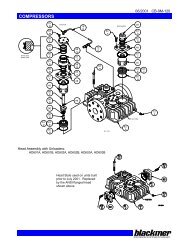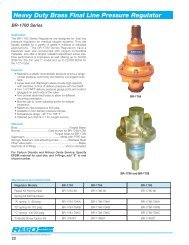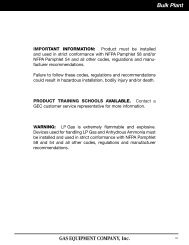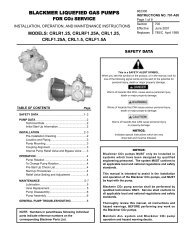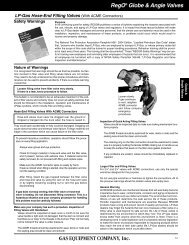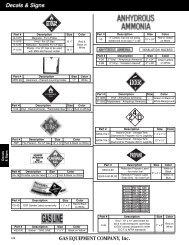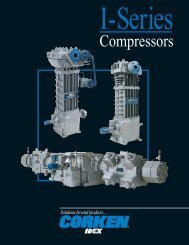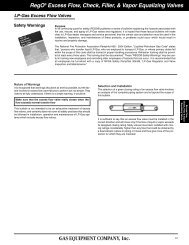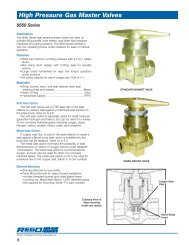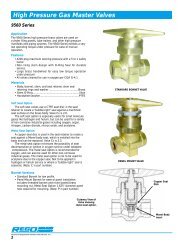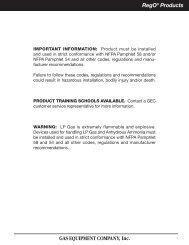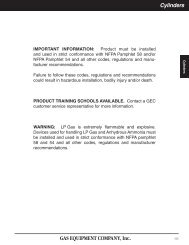RegO® Cylinder & Service Valves - Gas Equipment Company, Inc.
RegO® Cylinder & Service Valves - Gas Equipment Company, Inc.
RegO® Cylinder & Service Valves - Gas Equipment Company, Inc.
You also want an ePaper? Increase the reach of your titles
YUMPU automatically turns print PDFs into web optimized ePapers that Google loves.
RegO ® Excess Flow, Check, Filler, & Vapor Equalizing <strong>Valves</strong><br />
The Limitations of Excess Check <strong>Valves</strong> for LP-<strong>Gas</strong><br />
Excess flow check valves have been of help in limiting gas loss in many<br />
incidents involving breakage of hoses and transfer piping. Thus, they do<br />
provide a useful safety function in LP-<strong>Gas</strong> systems. However, there have<br />
also been transfer system accidents where excess flow valves have been<br />
ineffective in controlling gas loss due to a variety of conditions and to the<br />
inherent limitations of these valves. This bulletin explains what protection<br />
excess flow valves can offer, points out conditions which can interfere<br />
with that protection, and offers suggestions for effective excess flow<br />
valve installation.<br />
An excess flow valve is a protective device to help control the discharge<br />
of product in the event of complete breakage of pipe lines or hose rupture.<br />
However, an excess flow valve can only offer limited protection from<br />
gas discharge, because it will only close under those conditions which<br />
cause the flow through the valve to exceed its rated closing flow, and<br />
even when closed it necessarily allows some “bleed” past the valve.<br />
An excess flow valve is not designed to close and thus<br />
may not provide protection, if any of the following conditions<br />
are present:<br />
1. The piping system restrictions (due to pipe length, branches,<br />
reduction in pipe size, or number of other valves) decrease the<br />
flow rate to less than the valve’s closing flow. (Valve should be<br />
selected by closing flow rating — not just by pipe size).<br />
2. The break or damage to the downstream line is not large enough<br />
to allow enough flow to close the valve.<br />
3. A shut-off valve in the line is only partially open and will not allow<br />
enough flow to close the excess flow valve.<br />
4. LP-<strong>Gas</strong> pressure upstream of the excess flow valve, particularly<br />
due to low temperature, is not high enough to produce a closing<br />
flow rate.<br />
5. Foreign matter (such as welding slag) is lodged in the valve and<br />
prevents its closing.<br />
6. A buildup of process material (sludge), which may be found in<br />
LP-<strong>Gas</strong>, may occur over a period of time and cause the valve to<br />
stick open.<br />
7. The piping break or damage occurs upstream of an in-line excess<br />
flow valve, so the escaping product is not passing through the<br />
valve.<br />
8. The flow through the valve is in the wrong direction. (Excess flow<br />
valves only respond to flow in one direction.)<br />
9. The excess flow valve has been damaged, or is otherwise not in<br />
operating condition.<br />
Because of these limitations of excess flow valves, they should not be<br />
relied upon as the only means of controlling the escape of product in the<br />
event of piping damage. When possible, shut-off protection by quick<br />
closing valves, with shut-off controls accessible in spite of likely line damage,<br />
should be provided in addition to, or instead of excess flow valves.<br />
Where excess flow valves are installed, they should be<br />
checked to see that:<br />
1. They are installed in the correct direction — the arrow on the valve<br />
indicates the shut-off direction.<br />
2. The flow rating on the valve is proper for the installation. The rating<br />
must be above the normal system flow, but not higher than necessary<br />
to prevent “nuisance” closing in normal conditions. If the<br />
manufacturer’s catalog information is not sufficient, the valve suppliers<br />
can provide sizing assistance.<br />
3. In-line excess flow valves are installed so likely piping damage will<br />
occur downstream of the valve and will not separate the valve<br />
from the upstream piping.<br />
When the excess flow valves can be examined separate from the line<br />
(before the installation or if removed for system maintenance), they<br />
should be checked to see that the parts are in good condition and that<br />
the poppet can be pushed fully closed.<br />
Testing of Excess Flow <strong>Valves</strong><br />
In order to test an excess flow valve in a piping system, the flow<br />
through the valve must be made to exceed the valve’s closing rating.<br />
This testing should only be attempted by trained personnel familiar<br />
with the process. If no one at the facility has experience in proper<br />
testing, outside expert help should be obtained. The exact procedure<br />
used may vary with the installation, advisability of gas discharge, and<br />
availability of equipment.<br />
In general, most testing makes use of the fact that excess flow valves are<br />
“surge sensitive” and will close quicker under a sudden flow surge than<br />
under steady flow. A sufficient surge can often be created by using a<br />
quick-closing valve to control sudden, momentary flow into a tank or<br />
piping section containing very low pressure. An audible click from the<br />
excess flow valve (and corresponding stoppage of flow) indicates its<br />
closure.<br />
A test involving venting gas to the atmosphere is hazardous and may<br />
be impractical, or illegal.<br />
Any test of any excess flow valve will not prove that the valve will close in<br />
an emergency situation, due to reasons cited before. This test will only<br />
check the valve’s condition, and the flow rate sizing for those test conditions.<br />
For additional information on excess flow valves and other means of<br />
shut-off protection, contact Engineered Controls International, <strong>Inc</strong>. and<br />
refer to NFPA 58.<br />
Prepared by<br />
NATIONAL PROPANE GAS ASSOCIATION<br />
The purpose of this bulletin is to set forth general safety practices for the installation, operation,<br />
and maintenance of LP-<strong>Gas</strong> equipment. It is not intended to be an exhaustive treatment of the<br />
subject, and should not be interpreted as precluding other procedures which would enhance safe<br />
LP-<strong>Gas</strong> operations. The National Propane <strong>Gas</strong> Association assumes no liability for reliance on the<br />
contents of this bulletin.<br />
60



